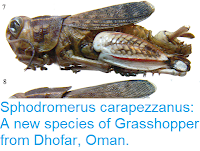Nations around the Red Sea are being threatened by a series of Desert Locusts, Schistocerca gregaria, that have been breeding in Sudan and Eritrea over the winter. The Insects often build up in numbers towards the end of summer in the region, but typically the end of the rainy season in October results in a fall-off of these numbers, but this year exceptionally wet weather in the region has enabled them to keep breeding through the dry season. A further two generations of Locusts have been born in East Africa since October, with one swarm crossing the Red Sea to Saudi Arabia, where they have also been reported to be breeding in the country's Empty Quarter, with Locusts reaching the borders of the United Arab Emirates, and potentially threatening Yemen, a country already devastated by war and famine, and potentially crossing the Persian Gulf to reach southern Iran, Pakistan or even India. Another swarm has been moving up the west coast of the Red Sea, and is thought likely to reach Egypt in the near future.
Desert Locusts in Abu Dhabi, United Arab Emirates, this month. Getty Images.
Desert Locusts typically have two or three generations in a year, but when conditions are favourable then five or more generations can occur. The females lay eggs in an ootheca (egg sack) in soft sand, where they can remain dormant until conditions are favourable or hatch within a few days. Hatchlings can reach maturity in about five weeks, eating as much as one-and-a-half times their body weight each day, when they are potentially able to breed again.
The adult form of the Desert Locust has two forms, the more usual solitary form, which does not usually move far from the area where they emerge, and a gregarious form, which forms large swarms and can roam long distances. The change from solitary to gregarious Locusts can happen in individuals, which change from one to the other in response to a rise in population density, but the reverse, a change from gregarious to solitary Locusts, can only happen when a new generation reaches maturity.
Solitary (top) and gregarious (bottom) Desert Locust nymphs. Compton Tucker/NASA/Goddard Space Flight Center/Wikimedia Commons.
See also...
Follow Sciency Thoughts on
Facebook.








